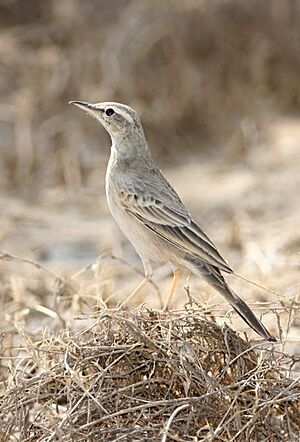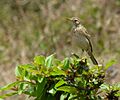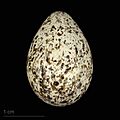Long-billed pipit facts for kids
Quick facts for kids Long-billed pipit |
|
|---|---|
 |
|
| Anthus similis decaptus | |
| Conservation status | |
| Scientific classification | |
| Genus: |
Anthus
|
| Species: |
similis
|
| Synonyms | |
|
Agrodroma similis |
|
The long-billed pipit or brown rock pipit (Anthus similis) is a type of passerine bird. These birds are found in many different places around the world. You can find them in Africa, across the Arabian peninsula, and in South Asia. Most long-billed pipits stay in one area, but some travel short distances.
Contents
About the Long-billed Pipit Family
Scientists are still learning about the long-billed pipit family. There are many birds that look similar. Sometimes, what was thought to be one type of bird is later found to be a completely different species!
For example, the wood pipit (Anthus nyassae) lives in Africa. It used to be considered the same species as the long-billed pipit. But now, most experts agree it's a separate species. Also, Bannerman's pipit (Anthus (similis) bannermani) from West Africa is sometimes seen as its own species. The Nicholson's pipit is another species recently separated from this group. It does not migrate and lives in southern Africa.
The first long-billed pipit was described by Thomas C. Jerdon in 1840. This type is found in parts of India. Other types, called subspecies, live in different areas. For instance, one type lives in Afghanistan, Pakistan, and parts of northwestern India. Another type is found along the Himalayan mountains. Some are even found in Myanmar and other parts of Asia and Africa.
What Does a Long-billed Pipit Look Like?
The long-billed pipit is a medium-sized bird. It is about 16 to 17.5 centimeters (6 to 7 inches) long. It's not very flashy, mostly sandy grey on top. Its belly is whitish or light brown.
This bird looks a lot like the tawny pipit. However, the long-billed pipit is a bit larger. It also has a longer tail and a longer, darker beak.
Sounds and Habits
The long-billed pipit flies strongly and in a straight line. It makes a special "chupp" sound. Its song is similar to the tawny pipit's, but it's slower and more varied. It sounds like "sri...churr...sri...churr..."
Like other pipits, these birds eat seeds and insects.
Reproduction and Life Cycle
Long-billed pipits build their nests on the ground. They like dry, open areas with rocks and low plants. Female pipits usually lay 2 to 4 eggs in their nest.
Images for kids






